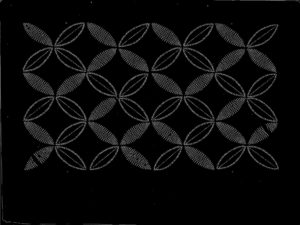Dr Alice Humphrey: mathematical analysis of katagami stencils
We have always known that the katagami stencils in MoDA’s collections are remarkable. Mathematical analysis by Dr Alice Humphrey has revealed more about just how extraordinary they are.
Alice undertook a mathematical analysis of many of the katagami in MoDA’s collection. She looked at the creation of shaded effects by means of differently spaced dots or ‘tonal gradation patterning’. Alice used tonal analysis techniques to identify and count each separate cut element in each katagami. She found that several of the katagami with fine dot patterning created by punches or drills have have over 16,000 separate cut elements!
Preliminary results

Alice research involved analysing the overall tonal range of the katagami using the software package ImageJ. She used this to identify the proportion of the designs that would be pigmented on the fabric if it were dyed. Her analysis has shown that there is a heavy preponderance towards dark designs, with 61% of the katagami being over 90% pigmented. This possibly has a practical element in that lighter (less pigmented) designs imply more cut out elements. Therefore the katagami required to print them are more fragile and are less likely to have survived. But this finding also accords with the Japanese aesthetics of restraint in the Edo period.
Alice has identified seven main categories of tonal gradation patterning on the basis of size, density and layout. She has also started to analyse the dot patterning types by looking at average dot area and range; spacing; and the arrangement of the patterning.
Development of an ‘applet’ design tool
Alice has developed three ‘applets’ which enable users to play with the variables within different patterns to see how this influences the overall effect.
These are still in development, but you can have a look at the different effects of variables within stripe patterning, dot halos, and comb-style patterning
This short film explains more about Alice’s research process:
You can also find out more about Alice’s approach in her symposium presentation: